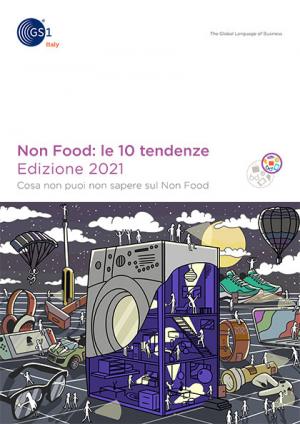New non-food trends in Italy
The Covid-19 pandemic has led to significant changes in purchasing patterns for non-food products, from clothing and household appliances to video games, telephony, DIY and home furnishings. GS1 Italy has analysed the impact on sales and the retail sector.
Milena Bernardi

What impact have new technologies and the Covid-19 pandemic had on supply and demand dynamics in the non-food consumer goods segment? For the first time ever, the GS1 Italy Non-Food Observatory has analysed the trends in a dedicated report entitled “Non-Food: the 10 trends. What you need to know about non-food”, which is summarised below.
The lockdown transforms purchasing decisions. A boom in edutainment and online purchases.
An analysis of the top ten consumption trends that have occurred during the Covid-19 pandemic clearly demonstrates that the dramatic lifestyle changes experienced by Italians have also impacted their non-food purchasing decisions. Being forced to lead more isolated lives has led consumers to neglect many of their former needs in favour of different kinds of products, choosing for example hair clippers, coffee machines, work desks, barbecues, exercise bikes, slippers and printers in place of lipsticks, sneakers and cameras.
While home working has mitigated the historic decline in sectors such as stationery and home textiles, edutainment has exceeded all forecasts with an increase in share of total Italian non-food sales from 3.2% to 4.9% over a period of five years (55.8% of sales are made online). Over the same five-year period, purchases of non-school books have grown by 16.7%, e-books by 37% in a year, audio books by 94% and video games by 180.1%. But the biggest boom of all concerns online shopping, which has seen a 417.5% increase over the reference period.
Online sales have been gaining share and value in all non-food sectors, most notably in consumer electronics (particularly telephony with a 74% increase in one year), textiles (+44.4%) and perfumery (+40.4%). And in the small appliance segment, the internet has become the leading sales channel with a 40.4% share by value.
Evolution of physical retail spaces
Town centre trade is still the most significant of the six types of retail space classified by the Non-Food Observatory. Italians have rediscovered this category during the pandemic due to its ability to respond more effectively to their needs in terms of proximity and services.
Physical stores such as opticians, computer shops, furniture and hardware stores, garden centres and garages are proving particularly resilient to changes in Italians’ non-food consumption patterns. They benefit from a nationwide distribution (with a presence in even the smallest towns), a high level of service, recognised professionalism and cost flexibility.
The Covid-19 pandemic has also prompted a rethink of shopping centre spaces, which have been severely penalised by the lockdowns and will have to adapt to consumers’ evolving needs for dining and entertainment venues rather than just places for shopping.
The pandemic has also fuelled strong growth in alternative forms of distribution, such as doorstep and mail order sales, vending machines and other outlets such as tobacconists, petrol stations and pharmacies. It has triggered an increase in purchases of personal hygiene products and vending machine sales of telephone accessories, while newsagents have seen an increase in sales of toys.
The effect of smart working and social networks
The continuation of smart working may result in long-term revitalisation of smaller towns and increase the appeal of decentralised locations compared to large cities. In this context, out-of-town commercial areas and metropolitan suburbs may also take the opportunity to strengthen their competitive position.
The increased use of the major social networks by modern non-food retailers reflects the growing number of people making online purchases (88 out of 100 Italians over the age of 14). Typical examples including opticians and non-school books, where the growth in online sales has been driven by influencers and bloggers along with their social media followers.
A more sober and essential lifestyle
The Covid-19 pandemic has inevitably fuelled a return to an essential lifestyle and consumption patterns while at the same time penalising the traditionally booming sector of luxury goods, which has also been impacted by the slump in foreign tourism. This trend is instead benefiting sales channels such as factory outlets and retail parks, while the second hand economy (especially fashion e-commerce) is continuing to expand and now sees the participation of more than half of all Italians.




















